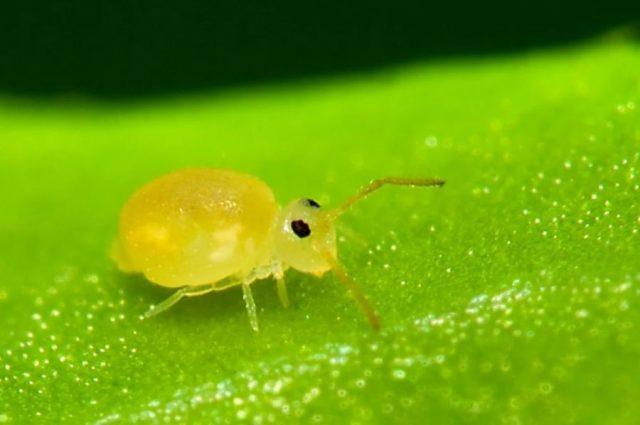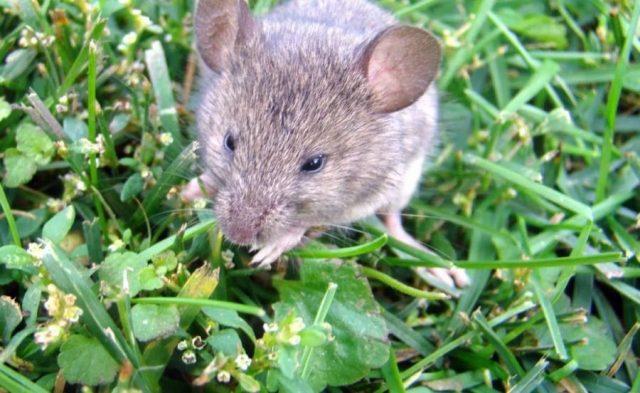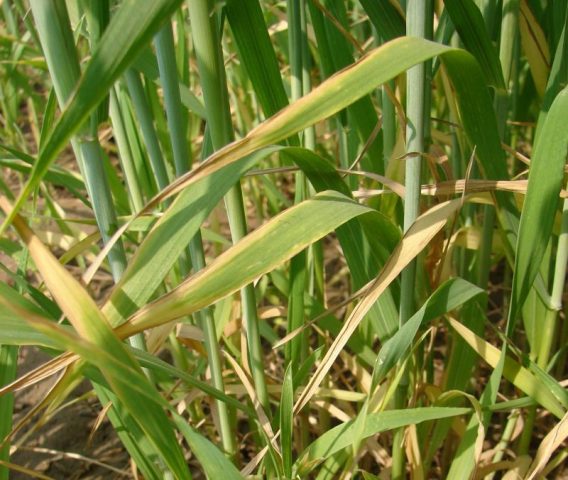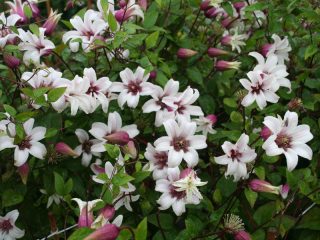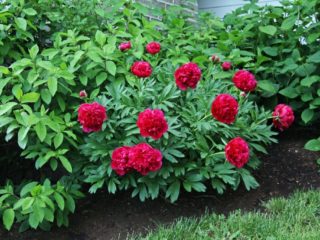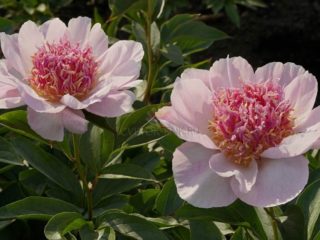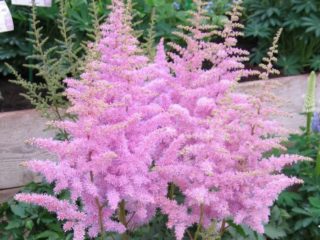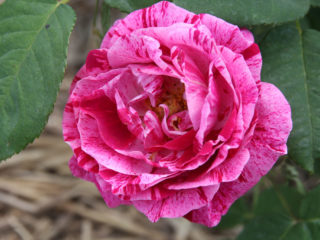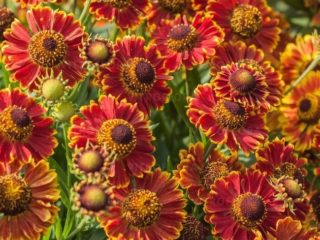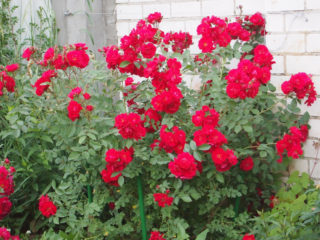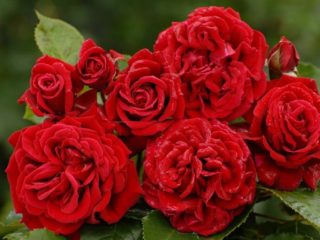Content
- 1 Description of the plant
- 2 What types and varieties to choose?
- 3 How to plant Eremurus
- 4 Caring for Eremurus in the garden
- 5 When and how to replant Eremurus
- 6 How to propagate Eremurus
- 7 Diseases and pests
- 8 Why doesn't Eremurus bloom?
- 9 Photo of Eremurus in landscape design
- 10 Conclusion
- 11 Reviews of Eremurus
The Eremurus flower looks attractive in garden design and does not require complex care. But before planting a plant, it is worth studying its requirements for conditions.
Description of the plant
Eremurus, or shiryash (Eremurus) is a herbaceous perennial of the Xanthorrhoeaceae family. It has a short fleshy rhizome, the shoots are spindle-shaped or cylindrical in shape. The stem of the flower is single, bare. The leaves rise directly from the root and form a rosette at the base of the bush. The plates are flat, linear-triangular, keel-shaped in the lower part.
The perennial is common in the southern regions of Europe, as well as in Central and Western Asia in dry areas. In Russia, you can find the plant in the Crimea and the Caucasus. The flower settles in sunny areas, prefers sandy loam or sandy soils.
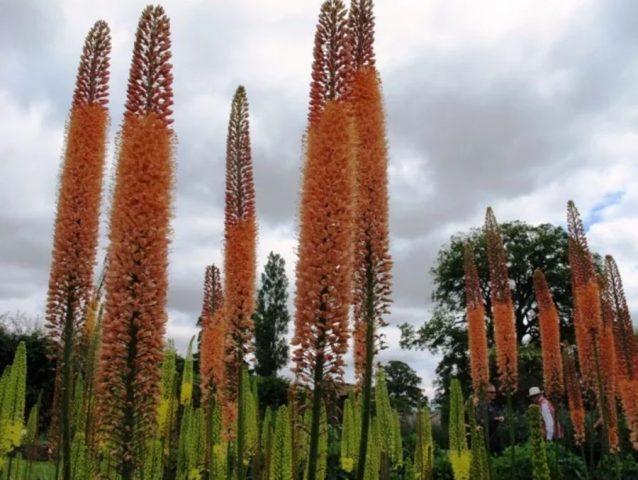
Eremurus flower, depending on the type, can reach 0.5-3 m in height
Winter hardiness of Eremurus
The perennial plant has average frost resistance. In temperate climates, Eremurus can withstand temperatures down to -28 °C. At the same time, the rhizomes of the plant require careful insulation from frost and wind.
When does Eremurus bloom?
Eremurus bears white, yellow, pink or brown buds, forming a large cluster, in early summer - at the end of May or early June. The perennial inflorescences are long, up to 60 cm, slightly pointed at the top.
The flowering period of Eremurus lasts about a month. Then the fruits are formed - spherical three-locular boxes with a wrinkled or smooth surface.
What types and varieties to choose?
Photos of Eremurus flowers in a flower bed show that the perennial is represented by a large number of varieties. There are several types that are most popular among gardeners.
Eremurus angustifolia
Narrow-leaved shirash, or Bunge (Eremurus stenophyllus) is a perennial up to 1.7 m tall. It has powerful simple shoots and a short vertical root with cord-like processes. The leaves of the plant are bluish-green, numerous, only about 2 cm wide. The inflorescences are cylindrical in shape and consist of small buds with a wide bell-shaped perianth.
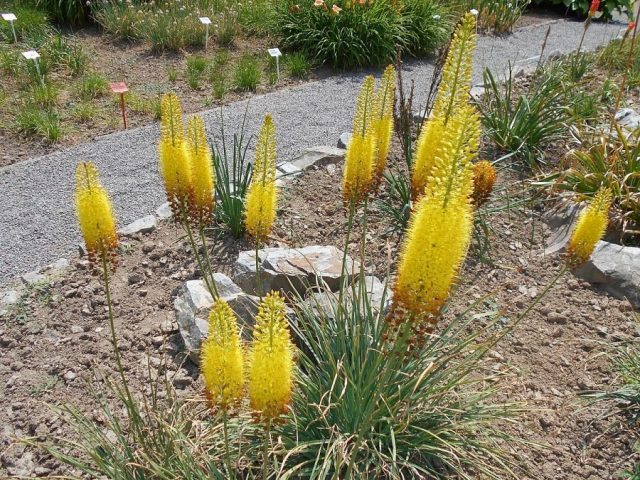
Inflorescences of narrow-leaved Eremurus can reach 80 cm in length
Eremurus is wonderful
The wonderful or representative shiryash (Eremurus spectabilis) reaches 2 m above the ground surface. It blooms in the middle period, usually blooming in May. Photos and descriptions of the yellow eremurus variety demonstrate that the buds of the variety are small with long stamens. The leaves are bluish in color, with a rough edge.
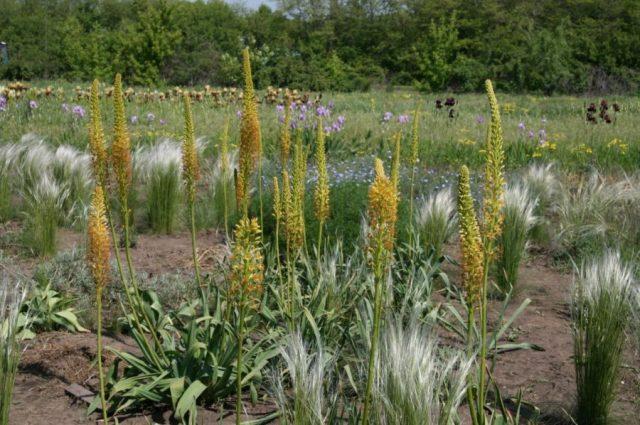
The wonderful shiryash begins to bloom for the first time 5-8 years after planting.
Eremurus himalayan
The Himalayan eremurus (Eremurus himalaicus) is distributed naturally in northeastern Afghanistan and the Western Himalayas. Reaches 1.8 m above the ground surface, the stem is bare, shiny, the leaves are keeled, bright green, up to 67 cm long. The plant bears cylindrical inflorescences consisting of buds up to 4 cm in diameter with white petals and thin staminate filaments. The decorative period begins in June and lasts until mid-summer.
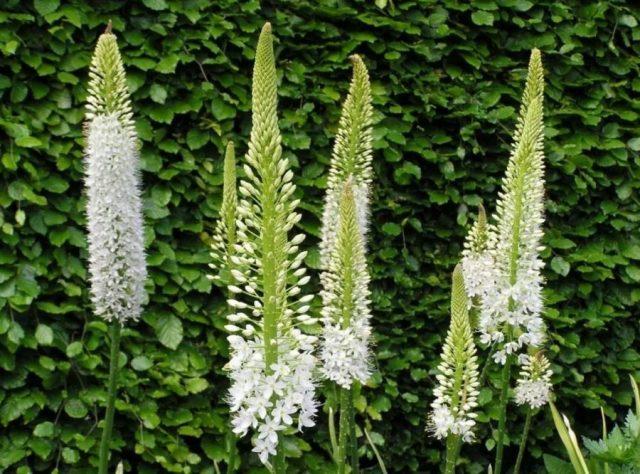
Himalayan shiryash has been known in culture since 1881
Eremurus powerful
Powerful shirash (Eremurus robustus) - a plant up to 1.2 m above the ground. Bears numerous white or light pink buds that look bright against the background of dark green leaves. Both on the plates and on the bare stem of the flower there is a slight bluish coating.
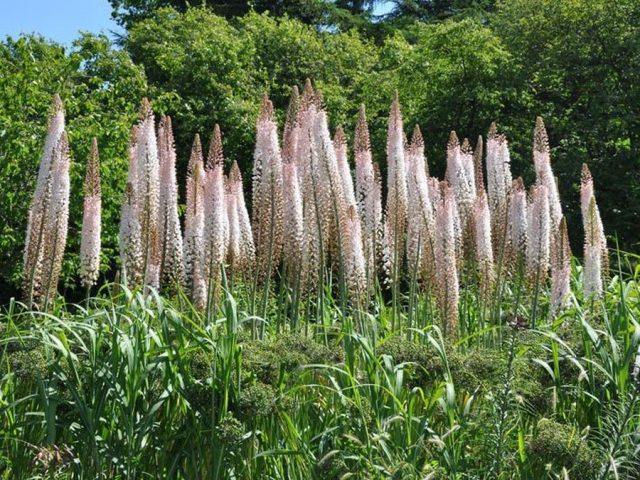
Powerful Eremurus grows in the foothills of the Tien Shan
Eremurus Crimean
Crimean Eremurus (Eremurus tauricus) is an endemic species that grows under natural conditions only in the Crimea and some regions of Transcaucasia. It has straight, non-leafy stems and long, wide-line leaves up to 60 cm. Photos and descriptions of the Crimean Eremurus show that the species bears apical snow-white inflorescences. The perennial is drought-resistant and is often found in pine forests and light deciduous forests, on limestone and shale.
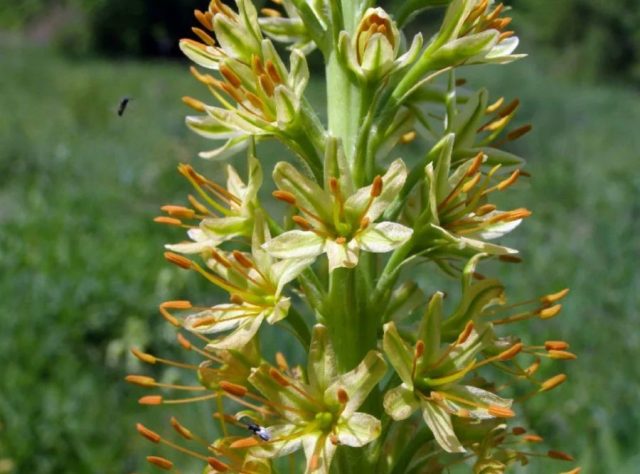
Crimean shiryash flowers appear from May to July
Eremurus altai
Altai Eremurus (Eremurus altaicus) rises up to 1.2 m above the ground. It has a short thick rhizome and arranged xiphoid or linear-lanceolate leaves.The length of the plates is about 40 cm. The plant blooms with pale yellow buds collected in brushes up to 30 cm long.
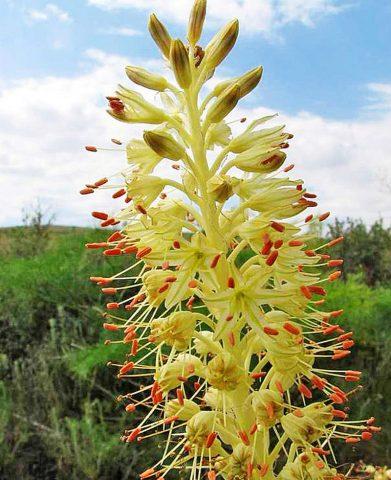
You can meet the Altai shiryash in Altai, as well as in the countries of Central Asia
How to plant Eremurus
Growing and caring for Eremurus does not involve much difficulty. The plant is transferred to open ground in the autumn - usually from early to mid-September. On the site for the perennial, select a sunny and open place with well-drained soil. The plant needs neutral or slightly alkaline soil; it can be placed on rocky ground.
The flower planting algorithm looks like this:
- The selected area is dug up, if necessary forming a raised bed for the plant.
- Prepare holes according to the number of plants up to 30 cm deep.
- Place pebbles or crushed stone at the bottom of the holes, and lay on top a layer of fertile soil made from a mixture of sand, turf soil and compost.
- Carefully transfer the seedlings into the holes and straighten the roots to the sides.
- Fill the holes completely and carefully compact the soil with your hands.
- Water abundantly with lukewarm water.
If you need to place several plants on the site, leave 50 cm of free space between them.
Caring for Eremurus in the garden
Caring for the Eremurus garden flower is quite simple. When planted correctly, the plant quickly takes root; in the future, you just need to provide it with proper care.
Watering
The plant is drought-resistant and does not require a lot of moisture. If you plant Eremurus in the spring, you will need to water it abundantly only 3-4 weeks before rooting.After the flower has taken root in the soil, the moisture intensity is reduced to a minimum. Watering is carried out only in hot weather with a long absence of precipitation. When planting in autumn, you need to moisten the soil before the first cold weather.
Settled lukewarm water should be used to water the flower. It is added to the soil in the absence of bright sun, in the morning or evening.
Feeding Eremurus
In the spring, you can feed Eremurus with a complex preparation containing nitrogen or rotted manure. Fertilizers will contribute to the growth of green mass and subsequent abundant flowering.
With the onset of autumn, superphosphate is added to the soil on the site at the rate of 40 g per 1 m2. Fertilizing will strengthen the flower's endurance and increase its winter hardiness. In general, the crop does not need abundant fertilizers - the perennial feels best on poor soil.
Trimming
The flower does not require decorative cutting. However, in summer it is recommended to remove wilted stems along with dried buds - this will preserve the attractiveness of the perennial.
Autumn pruning is carried out only after the natural yellowing of the leaves. The green plates cannot be touched - they continue to nourish the rhizome of the flower. If you trim the leaves ahead of time, the frost resistance of the perennial will suffer.
Supports
Low-growing varieties of flowers do not require support when grown. But next to tall bushes it is recommended to install wooden poles for gartering the stems. During the flowering period, the perennial may break due to strong winds.
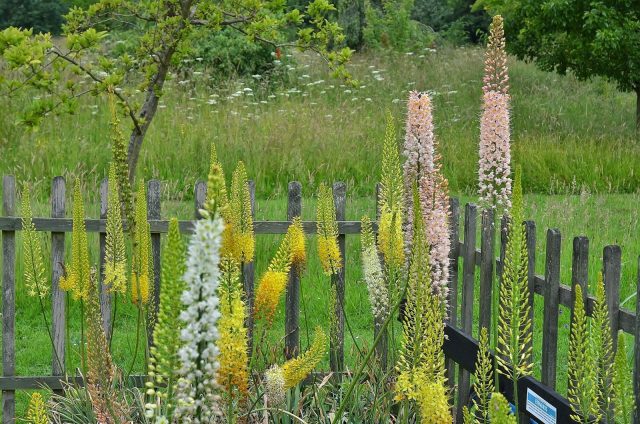
You can tie the eremurus to a fence or wooden fence for support
Wintering
The perennial Eremurus overwinters well without careful shelter in the middle zone and in the Moscow region.With the onset of autumn, it is only necessary to densely mulch the remains of the plant with leaves and spruce spruce branches in a layer of about 20 cm. Cold temperatures down to -30 ° C in this case will not cause any harm to the flower.
Eremurus in Siberia needs more careful shelter. A frame structure is built over the flowerbed and agrofibre is stretched over it, and then the perennial is additionally insulated with coniferous branches. If the winter is expected to be very cold, the flower can simply be dug out of the ground and stored in a dry, dark cellar until spring.
When and how to replant Eremurus
From time to time, a flower on the site requires replanting. About once every four years, the perennial is carefully dug out of the ground and the rhizomes are sorted out. The largest and healthiest specimens are planted in individual holes, small tubers are placed in small groups in common recesses.
Eremurus can be planted in early spring or mid-autumn. The flower must be at rest, otherwise it will be more difficult for it to take root in the soil.
How to propagate Eremurus
To propagate Eremurus, two methods are used - vegetative and seed. The first is used more often because it allows you to wait for flowering earlier.
By division
The flower actively reproduces by daughter rosettes that emerge from the ground next to the main plant. Children are transplanted according to the following scheme:
- Carefully separate the small rosette from the rhizome.
- Shiryash is treated with a fungicidal agent and root formation stimulator for rapid engraftment.
- Transfer the daughter plant to the prepared hole.
- Sprinkle with soil and water generously.
The division method is usually used once every 5-6 years. The procedure is recommended to be carried out at the end of summer or early autumn, after flowering has completed.
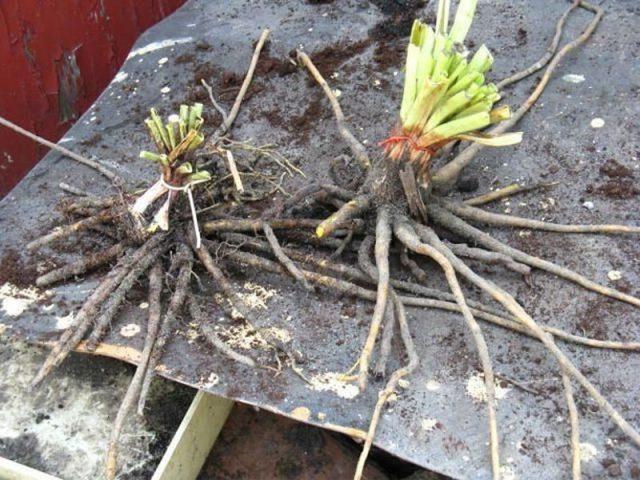
If the children do not separate from the adult Eremurus with light pressure, you should leave them in place until next year
Seeds
The flower can be propagated by seed. Planting of plants for seedlings is usually carried out in the fall at the end of September or at the beginning of October. For perennials, select a container up to 12 cm deep and fill it with nutritious but light soil.
The flower planting algorithm is used as follows:
- Seeds are planted in moist soil to a depth of 1.5 cm.
- Water the soil generously and cover the container with plastic wrap.
- With regular ventilation, the flower is germinated at a temperature of about 15 °C.
- If necessary, re-moisten the soil.
Eremurus shoots appear quite late - no earlier than in early spring. Some seedlings can germinate for up to two years. The seedlings are brought out into the fresh air for the first time a year after planting, having previously distributed the plants into individual pots. For the winter, the flower is not removed indoors, but it is carefully covered with compost or spruce branches. Stronger plants are transplanted into open ground only after three years.
Diseases and pests
If the rules of care are not followed, an ornamental flower may suffer from certain diseases and pests. The danger for him is:
- aphid - a small insect feeds on plant juices and slows down the development of the flower;
Spraying with a soap solution helps against aphids
- mice - the pest damages the roots of Eremurus and causes rapid death of the plant;
You can get rid of mice using poisoned baits
- chlorosis - perennial leaves with this disease turn pale and yellow;
Chlorosis affects shirash on too poor soil with low iron content
- rust - dark streaks and spots form on the plates of the plant, and the greenery gradually fades.
Rust on Eremurus develops in damp and warm weather
It is recommended to treat perennials against fungi with Fitosporin, Skor or Topaz, as well as copper sulfate. Spraying is carried out at the first signs of illness; severely damaged plants are simply removed from the site.
Why doesn't Eremurus bloom?
If Eremurus does not bear flower clusters, it is necessary, first of all, to calculate the age of the plant. The perennial begins to bloom in the fourth year of life; in some varieties, the first buds appear after 6-8 years.
If an adult Eremurus does not bloom, this may be due to several reasons:
- lack of sunlight;
- excess humidity;
- low temperatures.
The easiest way to revive Eremurus is if it does not bloom due to swampy soil. In this case, you need to reduce the frequency of watering and not flood the crop in the future. If a perennial is planted in a bad place and lacks heat and light, all that remains is to dig it up and move it to a more suitable area.
Photo of Eremurus in landscape design
Eremurus is used quite widely in landscape design - the flower is very decorative, hardy and does not require complex care. In the garden, perennials are planted as part of artistic flower beds, combining them with other crops. In particular, good neighbors for a flower are:
- roses and heleniums;
- rudbeckia;
- lavender;
- feverweed;
- lilies and gladioli;
- irises.
You can place the flower in a sunny area with dry rocky soil. The perennial does not suffer from direct sunlight and does not lose its brightness of color.
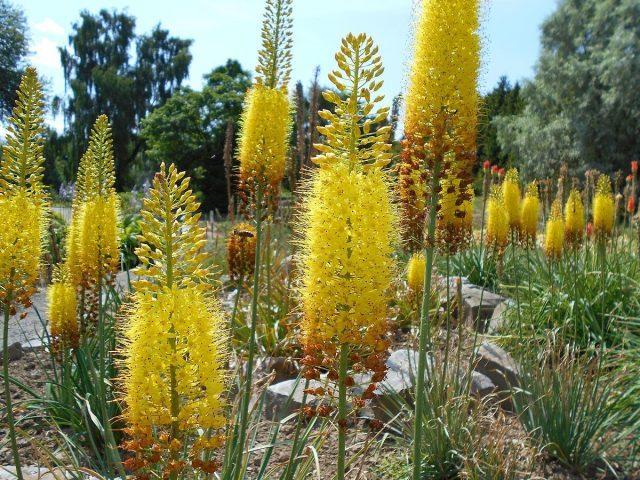
Eremurus looks harmonious in a rock garden next to ornamental cereals
Tall plant varieties allow you to form hedges and borders in the garden. In a flowerbed, the crop is placed in the background so that it does not block other perennials.
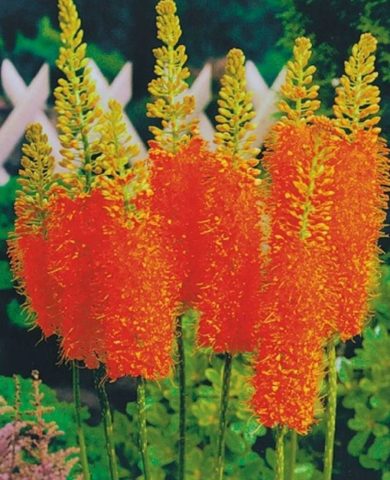
Eremurus does not fade in water for a long time, so it is often used for cutting
Conclusion
The Eremurus flower is unpretentious, coexists with most other perennials in the garden and rarely suffers from fungi. The main disadvantage of the plant is its slow development after planting.
Reviews of Eremurus
